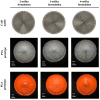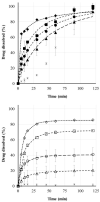Evaluation of Biodegradable PVA-Based 3D Printed Carriers during Dissolution
- PMID: 33799585
- PMCID: PMC7998734
- DOI: 10.3390/ma14061350
Evaluation of Biodegradable PVA-Based 3D Printed Carriers during Dissolution
Abstract
The presence of additive manufacturing, especially 3D printing, has the potential to revolutionize pharmaceutical manufacturing owing to the distinctive capabilities of personalized pharmaceutical manufacturing. This study's aim was to examine the behavior of commonly used polyvinyl alcohol (PVA) under in vitro dissolution conditions. Polylactic acid (PLA) was also used as a comparator. The carriers were designed and fabricated using computer-aided design (CAD). After printing the containers, the behavior of PVA under in vitro simulated biorelevant conditions was monitored by gravimetry and dynamic light scattering (DLS) methods. The results show that in all the dissolution media PVA carriers were dissolved; the particle size was under 300 nm. However, the dissolution rate was different in various dissolution media. In addition to studying the PVA, as drug delivery carriers, the kinetics of drug release were investigated. These dissolution test results accompanied with UV spectrophotometry tracking indirectly determine the possibilities for modifying the output of quality by computer design.
Keywords: 3D printing; computer aided design (CAD); dissolution study; dynamic light scattering (DLS); erosion test; fused deposition modelling (FDM).
Conflict of interest statement
The authors declare no conflict of interest.
Figures






References
-
- Center for Drug Evaluation and Research (CDER) Approval Package for SPRITAM. CDER; Rockville, MD, USA: 2015.
LinkOut - more resources
Full Text Sources
Other Literature Sources
Miscellaneous

